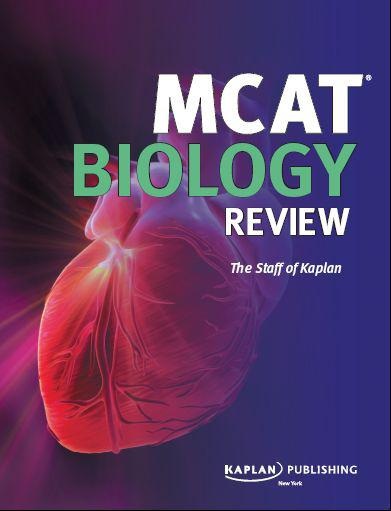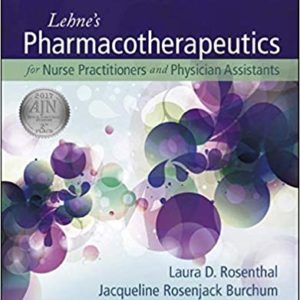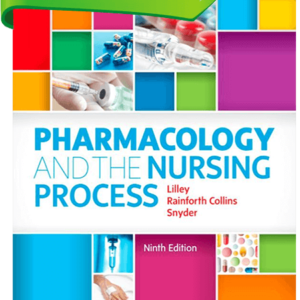Kaplan MCAT Biology Review by Kaplan
$5
Description
Kaplan MCAT Biology Review by Kaplan
Table of Contents
How to Use this Book
Introduction to the MCAT
Part I – Review
Chapter 1 – The Cell
Practice Questions
Chapter 2 – Enzymes
Practice Questions
Chapter 3 – Cellular Metabolism
Practice Questions
Chapter 4 – Reproduction
Practice Questions
Chapter 5 – Embryology
Practice Questions
Chapter 6 – The Musculoskeletal System
Practice Questions
Chapter 7 – Digestion
Practice Questions
Chapter 8 – Respiration
Practice Questions
Chapter 9 – The Cardio vascular System
Practice Questions
Chapter 10 – The Immune System
Practice Questions
Chapter 11 – Homeostasis
Practice Questions
Chapter 12 – The Endocrine System
Practice Questions
Chapter 13 – The Nervous System
Practice Questions
Chapter 14 – Genetics
Practice Questions
Chapter 15 – Molecular Genetics
Practice Questions
Chapter 16 – Evolution
Practice Questions
Chapter 17 – High-Yield Problem Solving Guide for Biology
Part II – Practice Sections
Practice Section 1
Practice Section 2
Practice Section 3
Answers and Explanations
Glossary
Related Titles
The Cell
I can remember when I was in your shoes. The MCAT loomed large on my
proverbial horizon. It was the first test that I can truly say that I was nervous to
take before I even cracked a book (and might even have been a little more
nervous after I saw how much I needed to learn). Some of you may be a little
nervous right now. That’s okay! It’s perfectly natural to feel some anxiety. But
we’re here to help you reduce your anxiety and channel your energy into action
that will lead to Test Day success. First, take a deep breath (breathing may be the
most natural thing we do, yet in a moment of panic, breathing is usually the first
thing that goes wrong) and relax. The next few paragraphs won’t be tested.
Rather, read them with an open and inquisitive mind. They will provide you with
a basis to do well not only on the MCAT but also as a physician.
To start, I would like to provide you with a fundamental insight that led me to
Test Day and medical school success.
Never be afraid to ask a question.
Sure. It sounds basic enough on the surface of it, but take a second to read it
again and really get your synaptic connections firing (I’ll wait). Those simple
words carry a great deal of meaning. On a surface-level analysis, the MCAT is
an exam based on questions: The test maker isn’t afraid to ask you questions,
and you shouldn’t be afraid to ask questions, either!
To whom exactly should you be directing your questions? Everyone, including
yourself. In a very literal sense, a question that you ask now might turn into a
correct answer (and another point) on Test Day. The only person you hurt by not
asking your questions is yourself.
And beyond the purpose of preparing for the MCAT, you should dig deeper in
your thought process and learn to ask difficult questions for which answers are
not always clear. I know that you aren’t all philosophy majors and some of you
may even dread liberal arts, but medicine as a field isn’t only about science. It’s
not enough to know that iron is a critical prosthetic group in hemoglobin and that
a deficiency could lead to anemia. Granted, there will be some nights during
which you will be responsible for recalling large amounts of information on only
a few hours of sleep, but that’s just a means to an end, not “the end in and of
itself,” to crib Kant.
The practice of medicine requires a physician and patient working together to
provide ideal treatment for a specific situation. It’s not enough for you (the
doctor) just to state, “Take two aspirin and call me in the morning,” as the old
saying goes. How do you arrive at the answers your patients (and you) seek? By
asking questions. Believe it or not, many times patients are afraid to question
their doctors. It’s almost hard to imagine as professionals trained in the art of
asking questions! Your patients will come to see you, pay you for your advice,
but may be afraid to ask questions such as “why?” (which can be both
profoundly simple and profoundly complex). Why this drug? Why this
treatment? Why is this happening to me? The way you ask questions will be a
model to your patients as you engage them as partners in the greater cause of
seeking health and wellness.
To ask—and answer—these questions correctly, ethically, and fully in your
future medical practice, you will need to make complete use of your critical
thinking skills—which snaps you back to the MCAT and the next few months of
your life.
The MCAT is designed to test your critical thinking. The test maker knows that
in order for you to be a successful physician tomorrow, you need to learn how to
ask questions today. In order to answer the questions your patients ask you, you
must ask questions of them. Similarly, to answer the questions the MCAT asks
you, you must ask questions of it. But learning to ask the right questions is only
the first step in the critical thinking process. You also need to learn to assess the
value and applicability of what you already know to what you will learn as you
ask questions and gather information. In your medical practice, you will seek
additional information from your patients, colleagues, lab tests, imaging studies,
and journal articles. For example, you will be expected to be able to come up
with a list of possible reasons for why your patient might have low iron (what’s
called the “differential diagnosis”), how to test for it, and how best to treat it. On
the MCAT, you will gather information from the passages and question stems
upon which the test is based and relate this information to what you already
know and understand.
Kaplan’s Review Notes and Test Day strategies are integral to the development
of your critical thinking skills. The information contained in these pages is highyield
and essential for Test Day success. I assure you that we have done our
homework in researching the topics that are included on the actual test. The
topics included in this book are likely to appear on your MCAT with varying
degrees of emphasis. Content areas not tested have been intentionally excluded
from our discussions here so that we do not waste your time and energy. Pay
attention not just to our discussion of content but also to our approach to solving
MCAT problems. Learn and practice our methods until they become your
methods. Upon the foundation of strong content understanding and time-proven
methods, you will build your critical thinking skills. These are the skills that will
allow you to reach the greatest heights of Test Day success.
So I encourage you to question yourself about your own knowledge and goals as
we take this journey through biology together. Take caution as you study these
notes. Beware of the extreme answer on practice questions. And don’t question
everything; I promise that biology is not a conspiracy theory. It is, after all,
based on chemistry, which is based on physics. (And let me assure you now, in
spite of how you may feel—and quite strongly too—physics itself is not a
conspiracy theory!)
Our first chapter will introduce us to the cell. To get us going, let’s look at a fun
fact. There are approximately 10 trillion cells in our body (that’s
10,000,000,000,000 to be exact) and approximately 100 trillion bacteria living in
our gastrointestinal tract. Bacteria outnumber us in our own bodies by a cell ratio
of 10:1. This, to say the least, gives new meaning to John Donne’s famous
saying that “No man is an island unto himself.” As we figuratively digest that
fact, we ought to begin to think about what we humans have in common with the
lowly bacteria living in our gut. Although we are markedly different, we share
some fundamental characteristics. The fundamental unit of the human body and
of each of those bacteria is the cell. Our goal in this chapter will be to understand
the basic structure and organization of the cell so that as we expand our focus to
the larger organ systems, we will have a solid foundation for MCAT success.
Cell Theory
Consider that biology has always lagged behind physics and chemistry in terms
of fundamental facts. Moreover, the majority of techniques that we now use to
study cells required advancements in other fields, especially chemistry and
physics. Biology doesn’t stand on its own legs. Physics allows us to understand
the fundamental laws of interaction in the universe; chemistry builds upon those
laws by explaining how reactivity occurs; biology expands the discussion at a
meta level to discuss how organisms interact. It wasn’t until the development of
microscopes in the 17th century that we were even able to look at our own
components “beneath the surface,” if you will, of visibility with the naked eye.
Over time, and through repeated examination at the microscopic level, we came
to recognize fundamental similarities among all living things. As with all good
scientific models, we start with a theory. This is one of the MCAT’s favorite
topics, and we should take careful note of the basic tenets of the Cell Theory.
The Cell Theory holds true for all organisms, whether they be unicellular or
multicellular:
• All living things are composed of cells.
• The cell is the basic functional unit of life.
• Cells arise only from pre-existing cells.
• Cells carry genetic information in the form of DNA. This genetic material
is passed on from parent to daughter cell.
MCAT Expertise
Know these points: The MCAT likes to test what sorts of systems could be
considered “cells.”
The Cell Theory may seem pretty basic, but complex systems are built from
these elementary rules. Consider that our own bodies (very sophisticated
machines in their own right) are ultimately a collection of cells all living by
these four rules! Pretty incredible and definitely test-worthy.
MCAT Expertise
Keep in mind that some passages will be experimental in nature; knowing
different experimental techniques will result in higher scores on Test Day.
Methods and Tools
One of the primary obstacles that prevented early scientists from being able to
study cells was their size. Ironically, we had lenses allowing us to peer into the
depths of space and predict where planets were stationed, yet not until we turned
these lenses inward did we begin to understand our own “inner space.” Today,
our primary techniques for examining the organism at the organ, tissue, cellular,
or subcellular levels are microscopy, autoradiography, and centrifugation.
MICROSCOPY
Of all the items in the biologist’s toolbox, the microscope is not only the one
most commonly used but also the one most commonly tested on the MCAT.
Two basic concepts that we should recall from the physics topic of light and
optics are magnification and resolution. We’re used to seeing these topics in
the Physical Sciences section on MCAT, but as we previously noted, biology
and physics are quite intertwined in real life! Magnification is the increase in
the apparent size of an object; basically, “How much bigger does it look?”
Imagine a tiny splinter painfully wedged into a friend’s pinky finger. Many of us
would search for a magnifying glass, because it enlarges the splinter’s image.
Resolution is the ability to differentiate two closely placed objects. Meaning,
once we position our magnifying glass and have a tweezer ready to attack, we’re
going to want to make sure we pull out only the splinter—and not a layer of our
friend’s skin!
Bridge
Although the power of a microscope is a physics concept, it is also tested in
biology.
Compound Light Microscope
This is the most commonly used type of microscope. Similar to telescopes
and other systems of lenses that we discuss in physics, a compound light
microscope uses two lenses or a system of lenses to magnify the object. The
total magnification power is the product of the two lenses: the eyepiece
(often 10×) and the objective (4×, 10×, 20×, or 100×). In other words, the
bacteria we might look at under a microscope may appear 100 times (or
more) larger than their actual size. Such organisms are truly microscopic.
While the MCAT isn’t likely to test us on the specifics of compound
microscopy, knowing the basic components can translate into easy points on
Test Day when such questions do appear (see Figure 1.1).
1. The diaphragm controls the amount of light passing through the
specimen, which is important for image contrast. Our cameras have
diaphragms for the same reason. Imagine taking a photo with the sun in
the background. The image doesn’t develop clearly; rather, it appears
washed out. The diaphragm can be adjusted to change the amount of
light allowed to pass through the lens. Without a diaphragm, it probably
wouldn’t show up at all.
2. The coarse adjustment knob roughly focuses the image. It does this
by moving the stage (platform on which the slide sits) up and down.
3. The fine adjustment knob finely focuses the image. Its function is
the same as the coarse knob’s, but it works over a smaller range of
focus.
By and large, compound light microscopes are for nonliving specimens. To
increase contrast, samples are usually sliced into thin sections, prepared by
using various chemical reagents, and then coverslipped. Sounds pretty brutal,
huh? Not surprisingly, the organisms usually die sometime during that
process. An example of a commonly used dye (which you don’t need to
memorize for the MCAT but will once you get to medical school) is
hematoxylin, which will show nucleic acids (DNA and RNA) within the cell
by binding to their negatively charged sugar-phosphate backbone moieties.
Phase Contrast Microscope
Although knowledge of the phase contrast microscope isn’t commonly
tested on the MCAT, we should know it for one major reason: It allows
for the visualization of living organisms. Samples are not prepared as
described above; rather, the microscope relies on differences in
refractive indices among the different subcellular structures (We said
that we’d see some physics!) This system provides a tradeoff: We are
able to view the live organism conducting its cellular activities, but we
aren’t able to increase the contrast of certain structures specifically by
using a dye or preparation technique.
MCAT Expertise
Don’t overfocus on the physics here; concepts such as refraction
are much more likely to be tested in the Physical Sciences section.
Electron Microscope
The most powerful microscope available to the biologist is the electron
microscope , which allows us to image down to the atomic level. Let’s
take a step back and consider how this process works. What is the
limiting factor in the resolution of the light microscope, or any
microscope for that matter? It is the medium that is used to transmit the
image. For example, in a light microscope, the resolution of the image
is limited by the wavelength of light, which is on the order of
nanometers. Images cannot be resolved further, as light cannot
distinctly transmit the information. An electron microscope uses a beam
of electrons; thus, its resolution is at the atomic level on the order of
picometers. Electron microscopy has paved the way for major advances
in the understanding of subcellular structures: for example, the ability to
visualize the interface between the inner and outer mitochondrial
membrane. The major drawback is the preparation technique: Samples
must be sliced very thinly and usually impregnated with heavy metals
(often OsO4) to allow for appropriate contrast. This requires the death of
the organism.
Bridge
We’ll hear more about the mitochondrial membranes

AUTORADIOGRAPHY
Another technique that relies on advances in chemistry and physics is
autoradiography. Recall that radioactive compounds decay or transform into
other compounds or elements through various processes such as alpha or beta
decay. We harness this power in various medical technologies including x-rays,
radioactive tracing, and nuclear medicine. For example, x-rays are capable of
penetrating the body and generating an image. We’ve all had the routine visit to
the dentist, during which images of our teeth are generated and used to identify
cavities. We should note that x-rays (and electromagnetic energy in general) can
be harmful. This is why it’s necessary for us to wear a lead apron during the
procedure: The heavy metal absorbs the high-energy rays and limits the
exposure of our vital organs to radiation.
On a cellular level, we can use radioactive decay to follow the biochemical
processes that occur in the cell. In a basic setup, cells are exposed to an essential
compound (glucose, nucleotides, amino acids, etc.) that they need to survive. We
manufacture these compounds such that they include radioactive atoms (e.g.,
tritium, an isotope of hydrogen). The cells are incubated for a given amount of
time and then fixed and put onto glass slides for microscopy. Each slide is
covered with a piece of photographic film and then kept in the dark to develop
for a given amount of time depending on the material used. The appearance of
an image on the photographic film shows the distribution of radioactive material
within the cell and where the biochemical reactions of interest took place. The
developed picture is a way to track processes of interest within the cell.
You must be logged in to post a review.





Reviews
There are no reviews yet.